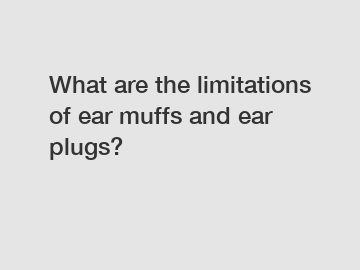What are the limitations of ear muffs and ear plugs?
What are the limitations of ear muffs and ear plugs?
Noise-induced hearing loss is a prevalent concern in today's world, particularly in workplaces and industries where exposure to loud sounds is frequent. To mitigate this risk, individuals often rely on ear protection devices like ear muffs and ear plugs. While these tools are widely used for their effectiveness in reducing noise levels, it is important to acknowledge that they do come with certain limitations. In this article, we will delve into the drawbacks of ear muffs and ear plugs, understanding their limitations and exploring potential alternatives.
1. Incompatibility with Communication: One of the primary limitations of ear muffs and ear plugs is the considerable reduction in the ability to communicate effectively. In environments where interpersonal communication is crucial, such as construction sites or emergency response teams, individuals wearing these devices may find it challenging to hear important instructions or warnings. This limitation can jeopardize safety, compromise teamwork, and hinder productivity.

2. Uncomfortable Fit: Ear muffs and ear plugs are typically manufactured as one-size-fits-all solutions. However, the reality is that everyone's ears are different in size and shape. Consequently, finding the perfect fit can be a challenge. Ill-fitting ear muffs may exert excessive pressure on the ears, causing discomfort, pain, and even headaches. Ear plugs, when not inserted correctly, may not provide adequate protection, allowing noise to filter through. These discomforts can discourage proper usage or lead to a false sense of protection.
3. Hygiene and Maintenance: Regular maintenance and hygiene are crucial when using ear protection devices. Ear muffs, being bulkier, are prone to accumulating sweat and dirt on their surfaces. This requires frequent cleaning to prevent infection or irritation. Ear plugs, whether disposable or reusable, also demand meticulous upkeep to prevent bacterial growth and contamination. Neglecting proper hygiene practices can compromise the device's effectiveness and pose health risks.
4. Limited Noise Reduction: Although ear muffs and ear plugs are designed to reduce noise levels, they have their limitations in terms of the degree of noise they can effectively block out. Extremely loud environments or prolonged exposure to high decibels can surpass the protection capability of these devices. In such cases, additional measures may be required, such as sound barriers or the implementation of engineering controls to minimize noise at its source.
Given the limitations associated with ear muffs and ear plugs, it is crucial to explore alternative solutions that address these shortcomings. Several advancements are being made in the field of hearing protection, striving to provide more effective and comfortable options.
1. Electronic Hearing Protection: Electronic ear muffs are gaining popularity as they offer the advantage of noise reduction while preserving the ability to hear important sounds. These devices use microphones to amplify low-level sounds, allowing wearers to communicate effectively while still protecting their ears from loud noises. Some advanced models even selectively filter out harmful frequencies while transmitting speech signals.
2. Custom-Made Hearing Protection: To ensure optimal comfort and protection, custom-made ear plugs are becoming increasingly popular. Molded to fit the unique contours of individuals' ears, these plugs provide a higher level of comfort, improved noise reduction, and a secure fit. While they may be relatively more expensive, their ability to address comfort and fit concerns make them a worthy investment for those frequently exposed to loud environments.
3. Noise-Canceling Headphones: Although primarily used for listening to music or canceling ambient noise, noise-canceling headphones can also serve as effective hearing protection devices. By employing active noise-canceling technology, these headphones can actively reduce environmental noise levels, offering a viable option in certain workplace settings.
In conclusion, while ear muffs and ear plugs are widely used for hearing protection, it is important to acknowledge their limitations. The compatibility with communication, uncomfortable fit, hygiene and maintenance requirements, and limited noise reduction are all significant drawbacks. However, advancements in technology have resulted in the development of alternative solutions such as electronic hearing protection, custom-made ear plugs, and noise-canceling headphones. By considering these alternatives, individuals can make more informed decisions regarding their hearing protection, ensuring both safety and comfort in their environments.
The company is the world’s best Types of Ear Protection, Bluetooth Ear Muffs for Mowing, Western Safety Ear Muffs supplier. We are your one-stop shop for all needs. Our staff are highly-specialized and will help you find the product you need.


